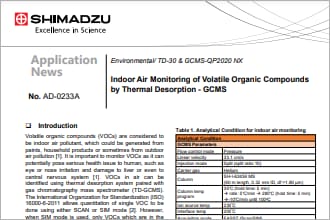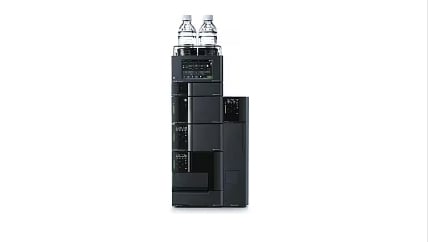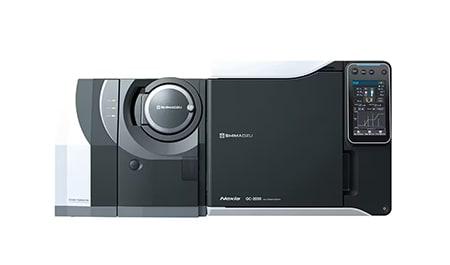Building upon 40 years of experience in LC technology, the Nexera series is a family of UHPLC systems that marries these AI and IoT enhancements to set new industry standards in terms of intelligence, efficiency, and design.
Indoor Air

It is necessary to take measures to prevent people from being exposed to substances causing sick house syndrome and toxic substances in the work environment such as painting, and to prevent health problems. Examples of analysis and measurement of regulated substances, hazardous substances, and ventilation in indoor and work environments are introduced.
Application News
HPLC
HPLC and Post-Column Derivatization with Acetylacetone
Formaldehyde, which is used as an ingredient of wood preservatives and resin products, has attracted considerable attention because it is a causative agent of the sick house syndrome. Ingredients contained in shampoos, skin lotions, foundation products, and other cosmetics are subject to particularly strict regulations because they are applied to the human body. Japan’s Standards for Cosmetics (Ministry of Health and Welfare Notification No. 331, 2000) prohibit the inclusion of formaldehyde in cosmetics. Moreover, in the EU, the content of formaldehyde in nail polish and other nail products is limited to no more than 5% under Regulation (EC) No. 1223/2009, Annex III. In this study, formaldehyde was detected in cosmetics using the HPLC method and post-column derivatization with acetylacetone, which is an established test method under the Methods of Analysis in Health Science (The Pharmaceutical Society of Japan, 2015). This article introduces formaldehyde analysis using a Nexera™ Series Nexera XR ultra high performance liquid chromatograph.
GCMS
Indoor Air Monitoring of Volatile Organic Compounds by Thermal Desorption - GCMS
Volatile organic compounds (VOCs) are considered to be indoor air pollutant, which could be generated from paints, household products or sometimes from outdoor air pollution [1]. It is important to monitor VOCs as it can potentially pose serious health issue to human, such as eye or nose irritation and damage to liver or even to central nervous system [1]. VOCs in air can be identified using thermal desorption system paired with gas chromatography mass spectrometer (TD-GCMS). The International Organization for Standardization (ISO) 16000-6-2011 allows quantitation of single VOC to be done using either SCAN or SIM mode [2]. However, when SIM mode is used, only VOCs which are in the targeted list can be identified. Other detected VOCs will be left unidentified. On the other hand, if only SCAN mode is used, lower quantitation limits cannot be achieved. Therefore, a method capable of running both SCAN and SIM simultaneously would be ideal. Here, we describe TD-GCMS method for the analysis of VOCs in indoor air. FASST mode (Fast Automated SCAN/SIM Type) was utilised to enable the quantitation of targeted VOCs, and at the same time, the identification of untargeted VOCs. In this study, the comparison of VOCs present in different locations (rooms) was also done.
Related Products
-
-
The Shimadzu triple-quad GCMS-TQ8050 NX is capable of performing unprecedented quantitative GC-MS/MS analyses of ultra-trace amounts, down to the femtogram level.






